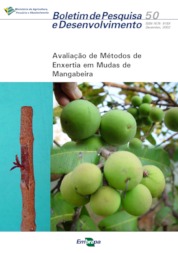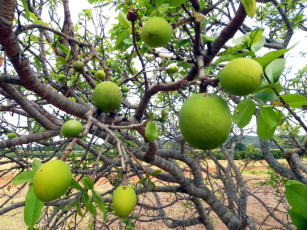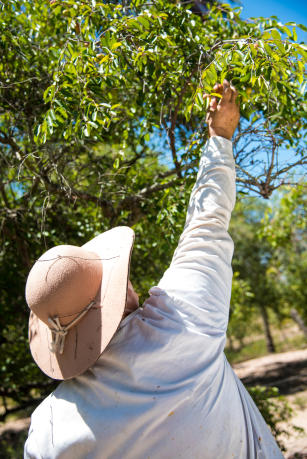Avaliação de métodos de enxertia em mudas de mangabeira.
Avaliação de métodos de enxertia em mudas de mangabeira.
Author(s): PEREIRA, E. B. C.; PEREIRA, A. V.; CHARCHAR, M. J. d'A.; PACHECO, A. R.; JUNQUEIRA, N. T. V.; FIALHO, J. de F.
Summary: RESUMO: Este trabalho foi conduzido no viveiro da Embrapa Cerrados, em Planaltina (DF), com o objetivo de avaliar a viabilidade da enxertia de mudas de mangabeira (Hancornia spp.) pelos métodos de garfagem lateral à inglesa simples, borbulhia de placa com janela aberta e borbulhia de escudo com lenho. A realização da enxertia ocorreu durante a estação chuvosa de verão. Os porta-enxertos apresentavam diâmetro do caule entre 0,5 e 1 cm a 10 cm do solo e foram produzidos em sacos plásticos de 20 x 30 cm. Para a obtenção dos enxertos, foram utilizadas quatro plantas-matriz em bom estado vegetativo, com folhas maduras nas últimas brotações e sem frutos. O delineamento experimental foi de blocos ao acaso, com três tratamentos (três métodos de enxertia) e oito repetições de dez enxertos (duas por planta-matriz, correspondendo a oito blocos). A abertura (retirada do amarrio) dos enxertos foi feita depois de 30 e 90 dias da borbulhia e da garfagem, respectivamente, porém, a avaliação do pegamento foi realizado aos três meses, computando-se apenas os enxertos brotados. Os resultados evidenciaram a viabilidade de clonagem de mangabeiras adultas pelos métodos de garfagem lateral e de borbulhia de placa com janela aberta. Os índices de pega dos enxertos variaram de 60% a 80% na garfagem e em torno de 90% na borbulhia de placa. Entretanto, a borbulhia de escudo com lenho mostrou-se inviável para a propagação da mangabeira, não apresentando pegamento de enxertos. ABSTRACT: This work was carried out in the nursery at the Embrapa Cerrados, in Planaltina, Federal District, Brazil. The objective was to evaluate the vegetative propagation of mangaba by the grafting and budding methods. Seedling rootstocks were grow in polybags of 20 cm x 30 cm and they had stem diameter ranging from 0,5 cm up to 1 cm at 10 cm above the ground. Both the grafts and the budsticks were taken from four adult fruiless plants with mature leaves in the last apical leaf flow. Twenty grafts were made from each source plant through the following methods: spliced side graft, patch buddind and chip budding. The experimental design was in randomized complete blocks, with eight replicates of ten plants per plot (two replicates per source plant). The wrapping tape was removed about 30 or 90 days after budding or grafting, respectively, and the final evaluation of bud and graft success was made in the latest epoch, taking in count the live and sprouted scions. Both the splice side graft and the pacth budding methods have shown to be promising for the vegetative propagation of mangaba, presenting graft success ranging from 60% to 80% and bud success about 90%. No bud success was observed for the chip budding method.
Publication year: 2002
Types of publication: Booklets
Unit: Embrapa Cerrados
Related content
Technologies See more
Observation
Some of Embrapa's publications are published as ePub files. To read them, use or download one of the following free software options to your computer or mobile device. Android: Google Play Books; IOS: iBooks; Windows and Linux: Calibre.
Access other publications
Access the Agricultural Research Database (BDPA) to consult Embrapa's full library collection and records.
Visit Embrapa Bookstore to purchase books and other publications sold by Embrapa.



